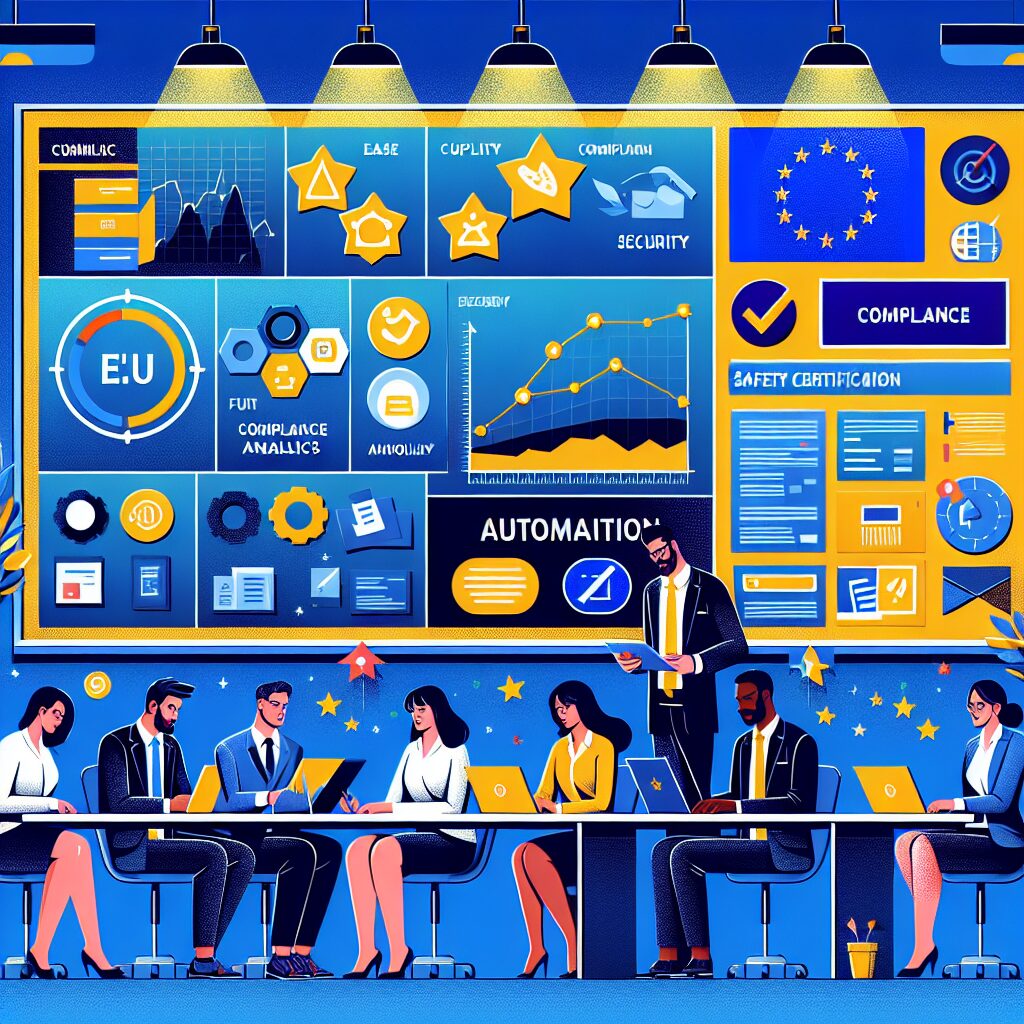About eldris
At Eldris, we automate SEO, multilingual site expansion, and EU compliance for brands scaling across Europe. Our AI-powered platform handles everything from content publishing to regulatory docs—so you don’t have to.
In This Article
- Use AI-driven tools to automate documentation and reporting.
- Optimise CE certification by pre-classifying product types correctly.
- Engage tech and legal partners with proven EU compliance expertise.
- Apply risk-based models to allocate compliance resources intelligently.
- SMEs should utilise consortiums and open-source tools to cut consultancy costs.
- Centralise cross-border compliance management for global scalability.
Understanding EU Compliance Cost Drivers
What Makes EU Regulatory Compliance Expensive?
The quest to reduce EU compliance costs begins by first understanding what inflates them. The European regulatory landscape is among the most stringent and multifaceted in the world. From CE certification to hazardous substance checks under REACH and RoHS, regulatory obligations span safety, environmental, and product labelling domains. For businesses exporting to or operating within the EU, compliance is non-negotiable—but not cheap.
Costs accrue fast due to several factors. First, regulatory updates occur frequently, requiring constant monitoring and response. Second, the documentation and testing burden is substantial. A single medical product, for instance, can require hundreds of pages of technical documentation. Third, language localisation for 27 EU member states adds translation and legal review layers. Lastly, audits and market surveillance create unpredictable budgetary spikes, especially if non-compliance is found. Together, these elements create a maze of administrative and legal traps that can heavily impact operational margins.

Automation: The Key to Lowering Compliance Costs
How AI and Cloud Tools Reduce Manual Work
One of the most decisive innovations allowing firms to reduce EU compliance costs is automation. By leveraging AI platforms and cloud-based regulatory software, businesses can dramatically cut labour-intensive processes. These digital solutions provide real-time updates on regulatory changes, auto-generate compliance reports, and manage multilingual documentation workflows with precision.
AI-driven compliance management systems reduce human error and shorten the document preparation cycle. They also offer sophisticated risk profiling tools. For instance, predictive analytics can assess which products are likely to come under stricter scrutiny, allowing proactive adjustments. Furthermore, cloud platforms permit collaborative compliance tasking across dispersed teams and regions—making it easier to standardise procedures across borders. When audits occur, firms can present dynamic dashboards and well-organised repositories, significantly lowering the risk of penalties.
“By integrating a single AI-based platform, we reduced our EU compliance costs by 42% while increasing regulatory response speed tenfold.” — Head of Compliance, Global Medical Devices Manufacturer
CE Certification Optimization Techniques
CE marking is mandatory for a broad range of products, yet it’s often misunderstood. Many businesses overengineer their CE conformity processes, leading to unnecessary expenditures. To reduce EU compliance costs, companies must strategically streamline their CE approach. Start by conducting a clear product categorisation under EU directives. Misclassification can lead to irrelevant testing costs or procedural duplication. Additionally, where standards overlap—such as consumer electronics and electromagnetic compatibility—modular test planning can prevent redundant lab analysis.
Engaging with a Notified Body early in design stages can also yield savings. Their insights help avoid costly redesigns later. Digital twin technology further enhances certification planning by simulating product performance without physical prototyping. This significantly decreases time-to-market and compliance budgeting uncertainties.
Reducing Documentation and Audit Complexity
Documentation remains one of the most resource-intensive aspects of EU compliance. However, firms looking to reduce EU compliance costs can minimise this burden through content reuse strategies. Establishing a master technical file template, then customising per product or market, allows a “write once, apply many” system. Integrated document management systems with version control and audit trail capabilities assist in meeting stringent traceability rules.
Audits, while unavoidable, don’t need to be disruptive. Pre-audit analytics and internal digital audits enable readiness with significantly reduced manpower. Regulatory intelligence dashboards highlight focus areas likely to be probed—allowing compliance teams to sharpen audit preparation. Furthermore, digital e-signatures and dynamic labelling reduce printing and validation delays. These initiatives cut both time and cost while improving audit outcomes.
Cross-Border Compliance Management for Global Brands
For multinationals, following disparate EU Member State interpretations of single directives adds significant overhead. Streamlining cross-border compliance is key to reducing EU compliance costs effectively. Investing in a centralised compliance hub—where local regulatory experts are embedded in global workflows—has shown high ROI. This avoids fragmented efforts and prevents duplication of localisation spend.
Moreover, leveraging the EU’s NLF (New Legislative Framework) harmonisation tools such as the EU declaration of conformity templates and standard EN protocols allow companies to align compliance across borders. Firms should also consider harmonised labelling standards to avoid repackaging costs. Centralised training and standardized SOPs further ensure consistency, enhancing operational efficiency across the entire value chain.
Cost-Saving Strategies for SMEs
Small and medium-sized enterprises often experience proportionally higher EU compliance costs due to limited in-house expertise. However, there are numerous tailored strategies to level the playing field. First, SME-focused regulatory consortia enable shared access to compliance intelligence and collective negotiation of testing services. Secondly, many Notified Bodies offer pre-certification checklists designed for SMEs, which can slash early-stage consultancy fees.
Digital compliance marketplaces are also a growing asset. Here, SMEs can compare pricing and turnaround times among EU-accredited testing laboratories—ensuring value for money. Open-source compliance templates, periodically audited for updates, provide a free foundation for technical documentation. Additionally, funding mechanisms such as EU’s COSME programme support compliance digitalisation initiatives for SMEs, directly helping to reduce EU compliance costs.
Risk Mitigation Without Compromising Safety
Many firms fear that cutting compliance costs might risk safety standards. However, systematic risk mitigation allows for efficiency without compromise. One effective method involves integrating safety-by-design principles early in product development. This avoids post-production modifications often required during CE certification.
Risk-based compliance strategies allow companies to allocate resources proportionally. High-risk product categories receive more stringent controls, while low-risk items follow streamlined processes. This resource allocation model, underpinned by quantitative risk assessment tools, ensures safety standards remain intact. Additionally, standardising supplier quality agreements reduces upstream non-compliance risk—shaving down associated corrective costs downstream.
Selecting the Right Legal and Tech Partners
Selecting appropriate partners is critical in the effort to reduce EU compliance costs. Legal advisors must have specialised regulatory law proficiency, preferably with multilingual capabilities for pan-EU deployment. The best firms are those who offer fixed-fee models and maintain direct liaison channels with regulatory bodies. They don’t just interpret the law—they anticipate future directives.
On the technology front, avoid fragmented legacy tools. Choose regulatory platforms with full life cycle coverage—spanning change tracking, compliance document warehousing, and multilingual labelling. Vet partners based on systems integration capabilities, user access controls, and data sovereignty alignment with EU GDPR regulations. Many businesses have achieved significant savings simply by switching to a cloud-native compliance ecosystem managed by a single trusted technology partner. For further guidance, see Learn more about EU Compliance Automation and Cost Efficiency and Approaches to reducing the EU regulatory burden.
Long-Term ROI From Compliance Automation
Reducing compliance costs isn’t merely a short-term fix. It’s a long-term investment in scalability and brand assurance. The ROI of compliance automation becomes evident in several dimensions. Firstly, time savings. Teams that once spent 40 hours a month on documentation now automate the process in under two. Secondly, error prevention. Automated validation reduces costly non-compliance incidents and reworks.
Moreover, customer trust increases when compliance transparency improves. Publicly accessible digital CE Declarations and real-time conformity data boost consumer and regulator confidence. Reduced legal liabilities and insurance premiums are additional financial benefits. Over a five-year horizon, many firms report compliance automation paying for itself multiple times over. Consider applying these principles alongside strategic cost-mapping tools from industry leaders like those in Read a related article and Seven EU electronics compliance pitfalls to avoid.
Case Studies: Successful Cost Reduction Stories
Case Study 1: A UK-based electronics SME reduced EU compliance costs by £120,000 annually by deploying a cloud-native regulatory platform. They imported all historical compliance documentation into a version-controlled repository, cut duplication, and halved test turnaround times.
Case Study 2: A multinational medical devices manufacturer used digital twins and AI testing simulation platforms. This resulted in a 38% reduction in CE preparation times, with enhanced first-time audit pass rates. They reported a three-year ROI of 472% from this change alone.
Case Study 3: An artisanal cosmetics exporter joined a compliance co-op, sharing local regulatory updates and documentation templates with others in the association. This strategic move halved their annual budget for regulatory consultancy and sped up their product rollouts to new EU markets.
Action Plan: Steps to Cut Costs and Stay Secure
1. Perform a full audit of current compliance processes. Identify redundancies.
2. Introduce AI-driven compliance automation tools.
3. Standardise documentation frameworks across product lines.
4. Engage legal experts for targeted regulatory forecasts.
5. Build or join industry coalitions for shared intelligence.
6. Prioritise risk-based compliance allocation models.
7. Reassess CE certification strategies by product class.
8. Consider cloud-native solutions with multi-language, full-lifecycle capabilities.
Conclusion: Smarter Compliance, Safer Outcomes
Reducing EU compliance costs is both an achievable goal and a strategic imperative in today’s regulated marketplace. Businesses that embrace automation, risk-based planning, and partnership synergies enhance not just operational efficiency but also market resilience. Ironically, in many cases, smarter compliance leads not to diminished safety—but to improved outcomes for users, regulators, and producers alike. As EU legislation continues to evolve, proactive, expert-led strategies will enable organisations to not only survive but lead in their respective sectors.
Great guide on reduce-eu-compliance-costs-without-sacrificing-safety – Community Feedback
How can brands cut EU compliance costs without risking safety?
Brands can implement process automation, centralised documentation, and AI-driven monitoring to meet EU regulations cost-effectively while ensuring safety requirements are fully met.
What automation tools are effective for EU regulatory compliance?
AI compliance platforms streamline document management, automate reporting, and flag risks in real-time, reducing manual effort and accelerating certification processes.
Are SMEs able to reduce their EU compliance burden?
Yes—by using cloud-based solutions, partnering with specialised compliance consultants, and digitising workflow, SMEs can lessen administrative load and cut regulatory costs.








